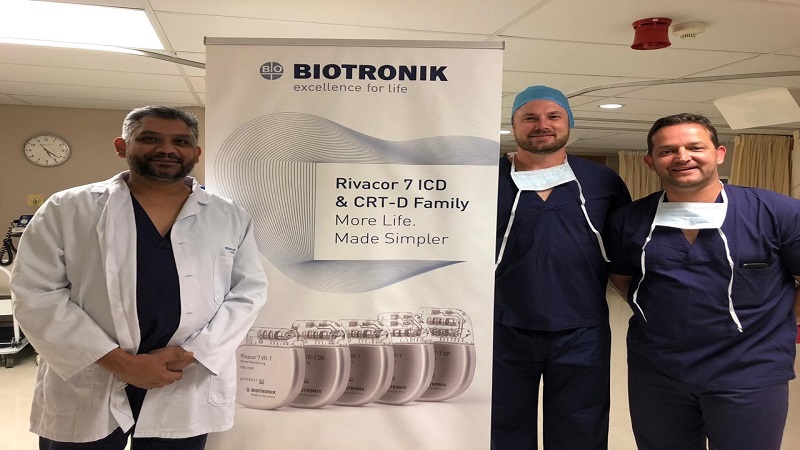A Cape Town medical team has launched the smallest implantable, fully functional 3 Tesla MRI compatible device that can control and manage life-threatening heart disorders. These devices, known as implantable cardioverter-defibrillators (ICD), are increasingly being used worldwide and also in developing countries, predominantly for the management of life-threatening cardiac rhythm disorders. The first implantation for the emerging markets region was performed over a week ago by cardiologist and electrophysiologist Dr. Razeen Gopal and his team at the CTAFC (Cape Town Atrial Fibrillation Centre) which he directs and which is situated in Panorama Medi-clinic in Cape Town.
The CTAFC, with its experience of using these devices and its leading role in teaching doctors about electrophysiology, implanted this device in a 77 year old patient with a condition known as ischaemic cardiomyopathy – poor cardiac function due to coronary artery disease. He has had a successful ablation of his ventricular tachycardia (life-threatening rhythm disturbance from the lower pumping chambers), with Dr. Gopal as well.
Speaking to VOC in-studio on Monday morning, Dr Gopal explained that disorders of the heart can be dangerous because the heart acts essentially as the body’s pump that gets blood throughout the body.
Using the example of a 40-year-old who has had a heart attack, he explained that damage to the heart muscle is treacherous, because it weakens its ability to pump effectively.
“Once the heart attack occurs it means there’s been a restriction of blood supply to the blood to the heart muscle (the myocardium). This damage to the heart muscle causes scarring. Heart attacks, often, if they are aborted early enough or the blood supply to the heart muscle is restored early enough, may not end with such scarring. The quicker we can get to the patient the less damage is done to the heart. But if we don’t then that area essentially dies off and forms the scar, which in turn then serves as a substrate for malignant deadly arrhythmias (rhythm disturbances)”.
Aside for the afore-mentioned, scarring also contributes to pump (heart) failure, for which this particular kind of device may be integral in maintaining life.
Many people are familiar with the fact that pacemakers literally “set the pace of the heart” in order to have it beating in a regular manner. It does this by increasing or maintaining the heart rate using an electric impulse. These can also be used to restore the heart’s beating if the heart suddenly stops.
According to Dr Gopal, different types of devices have different actions. Automated external defibrillators (AEDs) were developed to save the lives of people experiencing sudden cardiac arrest in particular outside of hospitals. Even untrained bystanders can use these devices in an emergency, and they are usually available in areas such as airports, sport grounds etc.
However, defibrillators can prevent sudden death among people who have a high risk of a life-threatening arrhythmia. They include implantable cardioverter defibrillators (ICDs), which are surgically placed inside your body, and wearable cardioverter defibrillators (WCDs), which rest on the body like a vest. A subcutaneous, leadless form is now also available. It can take time and effort to get used to living with a defibrillator, and it is important to be aware of possible risks and complications.
Dr Gopal explained that the re-synchronization aspect of therapy is what allows for the failing or arrhythmic heart to be strengthened. He revealed that this latest device (and others similar to it), launched in April, through a company called Biotronik, may delay the progression of such damage.

CRYO RELEASE
The most commonly treated rhythm disorder is atrial fibrillation, known as AF or Afib, which affects the upper chambers of the heart (atria).
According to health website www.medtronic.com, “atrial fibrillation is an irregular, rapid heart rate that may cause symptoms like heart palpitations, fatigue, and shortness of breath. As a result of beating out of rhythm, blood is not pumped efficiently to the rest of the body, causing an unusually fast heart rate, quivering, or thumping sensations in the heart.”
The quality of life is lowered and those who suffer from AF are five to seven times more likely to form blood clots or suffer a stroke. Fortunately, AF may be treated with medication, or preferably cured with a catheter ablation procedure such as cryo-ablation, for which the CTAFC is world-renowned.
For more information, visit www.capetownafcentre.co.za
VOC






 WhatsApp us
WhatsApp us 


2 comments
My Dr told me i have only about 40% function left on heart.i had 6 stents all blocked.heart pain 24/7 and a diabetic.high blood.and anxiety. Had a triple bypass also.Help me pleaseeee..i am almost 56..
Doctor Gopal is there any cure for a prolapse mitral valve please